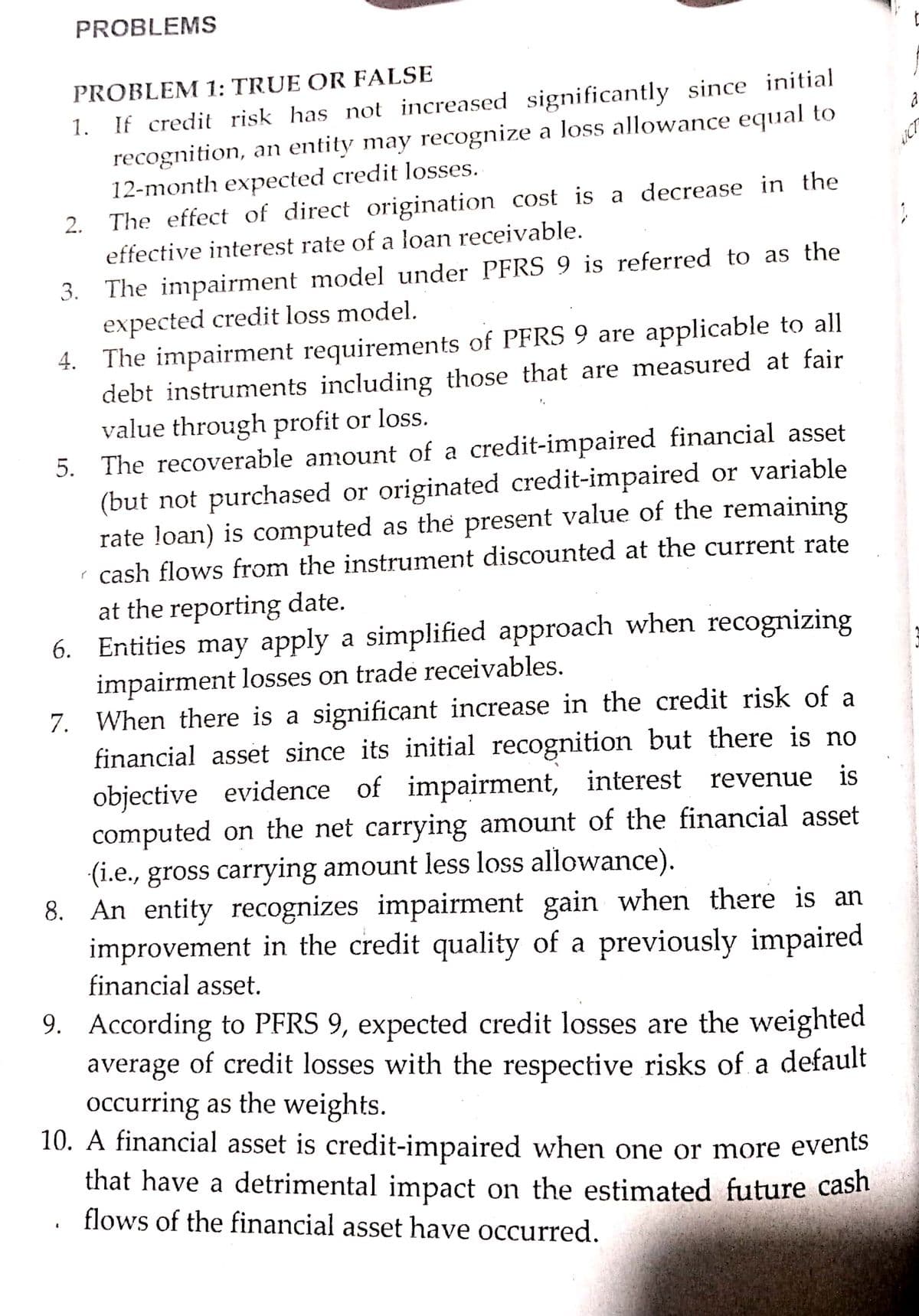PROBLEM 1: TRUE OR FALSE If credit risk has not increased significantly since initial recognition, an entity may recognize a loss allowance equal to 12-month expected credit losses. The effect of direct origination cost is a decrease in the 1.
PROBLEM 1: TRUE OR FALSE If credit risk has not increased significantly since initial recognition, an entity may recognize a loss allowance equal to 12-month expected credit losses. The effect of direct origination cost is a decrease in the 1.
Chapter1: Taking Risks And Making Profits Within The Dynamic Business Environment
Section: Chapter Questions
Problem 1CE
Related questions
Question
With explanation please

Transcribed Image Text:PROBLEMS
PROBLEM 1: TRUE OR FALSE
1. If credit risk has not increased significantly since initial
recognition, an entity may recognize a loss allowance equal to
12-month expected credit losses.
2. The effect of direct origination cost is a decrease in the
effective interest rate of a loan receivable.
3. The impairment model under PFRS 9 is referred to as the
expected credit loss model.
4. The impairment requirements of PFRS 9 are applicable to all
debt instruments including those that are measured at fair
value through profit or loss.
5. The recoverable amount of a credit-impaired financial asset
(but not purchased or originated credit-impaired or variable
rate loan) is computed as the present value of the remaining
r cash flows from the instrument discounted at the current rate
at the reporting date.
6. Entities may apply a simplified approach when recognizing
impairment losses on trade receivables.
7. When there is a significant increase in the credit risk of a
financial asset since its initial recognition but there is no
objective evidence of impairment, interest revenue is
computed on the net carrying amount of the financial asset
(i.e., gross carrying amount less loss allowance).
8. An entity recognizes impairment gain when there is an
improvement in the credit quality of a previously impaired
financial asset.
9. According to PFRS 9, expected credit losses are the weighted
average of credit losses with the respective risks of a default
Occurring as the weights.
10. A financial asset is credit-impaired when one or more events
that have a detrimental impact on the estimated future cash
flows of the financial asset have occurred.
Expert Solution
This question has been solved!
Explore an expertly crafted, step-by-step solution for a thorough understanding of key concepts.
Step by step
Solved in 2 steps

Recommended textbooks for you

Understanding Business
Management
ISBN:
9781259929434
Author:
William Nickels
Publisher:
McGraw-Hill Education

Management (14th Edition)
Management
ISBN:
9780134527604
Author:
Stephen P. Robbins, Mary A. Coulter
Publisher:
PEARSON

Spreadsheet Modeling & Decision Analysis: A Pract…
Management
ISBN:
9781305947412
Author:
Cliff Ragsdale
Publisher:
Cengage Learning

Understanding Business
Management
ISBN:
9781259929434
Author:
William Nickels
Publisher:
McGraw-Hill Education

Management (14th Edition)
Management
ISBN:
9780134527604
Author:
Stephen P. Robbins, Mary A. Coulter
Publisher:
PEARSON

Spreadsheet Modeling & Decision Analysis: A Pract…
Management
ISBN:
9781305947412
Author:
Cliff Ragsdale
Publisher:
Cengage Learning

Management Information Systems: Managing The Digi…
Management
ISBN:
9780135191798
Author:
Kenneth C. Laudon, Jane P. Laudon
Publisher:
PEARSON

Business Essentials (12th Edition) (What's New in…
Management
ISBN:
9780134728391
Author:
Ronald J. Ebert, Ricky W. Griffin
Publisher:
PEARSON

Fundamentals of Management (10th Edition)
Management
ISBN:
9780134237473
Author:
Stephen P. Robbins, Mary A. Coulter, David A. De Cenzo
Publisher:
PEARSON